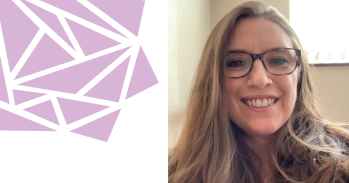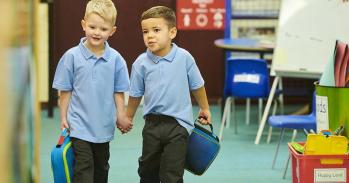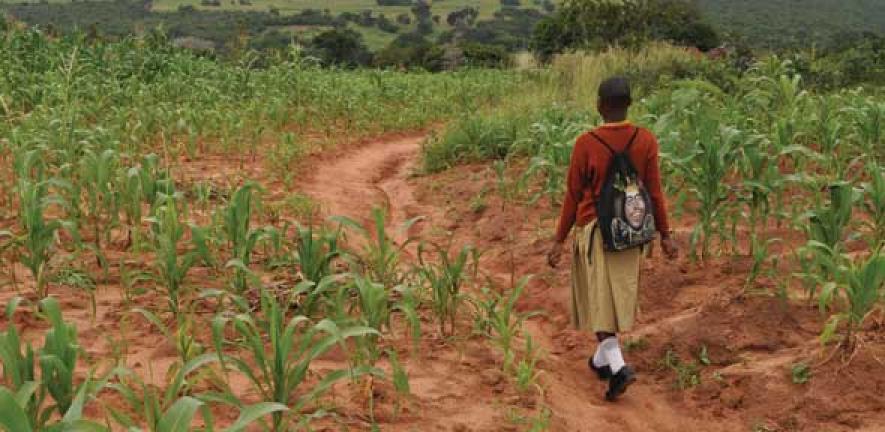
Half the children in Africa miss out on school and basic learning as a result of poverty, gender or disability. While major efforts are being made to reverse this situation, Cambridge researchers are working with NGOs on the ground to ask what works, why and how much it costs.
Half the children in Africa miss out on school and basic learning as a result of poverty, gender or disability. While major efforts are being made to reverse this situation, Cambridge researchers are working with NGOs on the ground to ask what works, why and how much it costs.
It’s a powerful piece of knowledge for any government to know what to look at in policies around education
Lucy Lake, CEO Camfed
By the time she was 13 years old, Vumilia had supported herself through primary school by collecting and selling firewood. Now she faced an even greater challenge. After weeks of anxiety, Vumilia left home at 4.30 a.m. to walk the 10 km to secondary school; she had no pencils, no uniform and no money to pay her school fees.
Twelve-year-old Husna had no choice but to leave school to work, helping to support her grandmother and siblings on her US$14 a month working as a housemaid. Husna would wonder what lay ahead of her: “I was imagining that my life would be horrible. Because even if I stopped being a maid,where would I go? What would I do?”
Catherine also saw a bleak future. After the death of her father, her uncles took her family’s land. Some days Catherine would manage to go to school; on others she would sell food by the roadside. “I would see other children studying and all the time I would just look at their exercise books and try to learn. I was imagining my future as going into a big hole where no one could help me. A girl without education is nothing in the world. Education is everything.”
Vumilia, Husna and Catherine all live in Tanzania in East Africa. With an economy based largely on agriculture, Tanzania has among the lowest rate of secondary school enrolment in Africa. Many girls from poor, rural families can’t afford the cost of going to secondary school and leave home to become ‘house girls’ in urban centres. There, they sometimes experience abuse and exploitation, returning home infected with HIV, or pregnant. Sadly, Catherine’s prediction of a desperate future is all too accurate.
“Education is a fundamental human right,” says Professor Pauline Rose from Cambridge’s Faculty of Education, “but moving between that undeniable statement and on-the-ground change is a long and complex process. Education is at the heart of social transformation – it increases opportunities in life, can pull people out of poverty, empower women and drive economic growth. Understanding the barriers that prevent this happening is crucial.”
Rose is Director of the Research for Equitable Access and Learning (REAL) Centre in the Faculty of Education. Working with NGOs, schools and education policymakers in African countries, India and Pakistan, her team is highlighting the factors that limit children’s learning and the mechanisms that can improve the effectiveness of teaching.
“Firstly, children need to be able to access primary and secondary school. But it is also important to make sure that this is valuable – there’s little point in being in school if children don’t learn the skills they need,” she explains. “And while this needs to happen for all children, we know that it is often girls from poor households who are the most disadvantaged when it comes to completing education.”
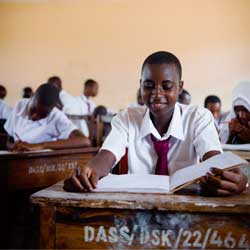
Fortunately for Vumilia, Husna and Catherine, they are now among over 40,000 Tanzanian girls who in the past decade have been helped into secondary education by the non-profit organisation Camfed (Campaign for Female Education), with whom the REAL team has a research partnership.
Since 1993, Camfed has supported more than 1.6 million students in five African countries to attend primary and secondary school, and has benefited nearly four million children through the provision of improved learning. A range of barriers to schooling are targeted through scholarships, mentoring, educational resources and community-led initiatives.
The organisation particularly focuses on those girls who are poorest and most likely to be excluded from the school system, and at an age where they are at greater risk of dropping out due to poverty, early marriage or pregnancy.
“There is a pressure in the development sector to want to find the ‘silver bullet’ – find the vaccine – in terms of what can be done to effect social change,” explains Camfed CEO Lucy Lake. “We see girls’ education as the starting point to everything – from tackling poverty and early mortality through to driving economic development – it generates a multiplier effect like no other.”
However, Lake is quick to point out that there is still much to be done to raise learning outcomes for all, and that evidence is crucial. “Reducing the chance that children leave school early or without basic literacy and numeracy skills is clearly important but which interventions work best, with whom and when?”
Rose’s team is helping Camfed unpick the basis of the organisation’s on-the-ground results. Building on the evidence of Camfed’s successful programme, the research will not only provide a unique large-scale analysis of the cost-effectiveness of educational programmes, but will also contribute to understanding how they can be sustained.
“An obvious point, but an important one to make, is that it’s not that poor children can’t learn,” says Rose. “It’s that the conditions that affect whether they go to school and stay in education are much worse. Our evidence shows for instance that when poor children and rich children are in the same class there’s a very, very narrow learning gap. But what is less clear is by what mechanism targeted support can level the playing field.”
Rose continues: “It’s all very well saying how beneficial Camfed’s programme is but we also need to assess why, and how this can be replicated across an education system.”
Three years ago, Camfed won funding from the UK’s Department for International Development (DFID) to scale up their work as part of the Girls’ Education Challenge programme. Lake describes how they saw this as an opportunity to do this at the community level rather than at an organisational level. “More girls would gain if we could scale locally without needing to grow a costly and potentially unsustainable organisation at this end,” she explains.
“Because disadvantage is so nuanced, we work with local communities to identify who should receive scholarships. As a result, there’s a sense that these are the community’s resources and not the resources of an organisation coming in and making decisions.”
Securing funding from DFID was also an opportunity to take a critical look at precisely how Camfed’s programmes are meeting the needs of those who are most marginalised. Camfed routinely collects data for evaluation purposes and they now turned this over to Rose’s team at the REAL Centre for deeper analysis.
Rose explains: “We are independent – we aren’t wishing to make a case one way or the other. We could see how these data could help us uncover the factors that limit children’s learning, which could have lessons beyond Camfed’s own programme. Globally, even after going to school, 250 million children cannot read, write or count. It’s been described by UNESCO as a global learning crisis.”
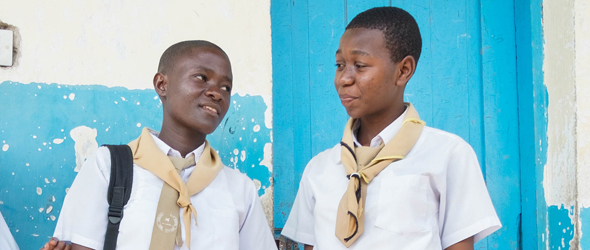
With funding from Echnida Giving, the REAL team has recently completed its first analysis of Camfed’s data in Tanzania, comparing enrolment and learning outcomes for girls supported by the organisation with those for girls who didn’t receive support. “We found that marginalised girls receiving a bursary were about 30% more likely to stay in education, and those in Camfed-supported schools on average tripled their assessment scores compared with those in other schools,” Rose says.
They also looked at how the Camfed programme’s influence on self-esteem affected learning. In particular, a system of ‘Learner Guides’ aims to expand the presence of female role models, lead students through a broad life skills curriculum, organise academic study groups, and provide counselling and follow-up on students in danger of dropping out. Again the programme was found to benefit the learning of those identified as having low self-esteem before the intervention.
“We have quantitative evidence that what Camfed is doing works,” Rose adds. “The next questions are: how much does it cost to reach the most marginalised girls, how far can it be scaled up and how sustainable is it?”
National governments need these answers to consider policy changes and budget allocation. In fact, Camfed’s approach has always been to work in tandem with local stakeholders.
“Whenever we start in a country, we never start with setting up an office, we always start with the Ministry of Education,” says Lake. “We work with them to identify those areas where there is the greatest disparity in terms of enrolment, academic performance and so on, and where it makes sense for us to come in as a partner to work on improving those areas.”
However, as with any NGO, there is always a danger that if funds were to run out then the programmes could falter and fail. Understanding cost-effectiveness, says Rose, is imperative to understanding how any NGO programme can be sustained: “There have been assessments for how to improve access to school and how to improve learning but very little on both together.”
Lake highlights the timeliness of the study: “While there’s a general movement towards ensuring that there’s free education for all, there’s a real concern that expansion in secondary level provision might lead to exclusion of those who are most marginalised.”
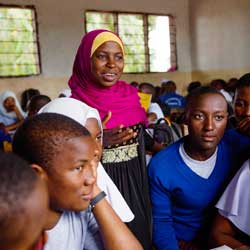
It’s also vital not to lose sight of primary education in the mix, says Rose: “There’s only so much you can fix once children get to secondary school. If you don’t start early enough then you will only have a select group of children who will benefit from improved education later.”
Her team works with the People’s Action for Learning (PAL) Network – an independent organisation that measures basic reading and numeracy abilities of children across three continents through annual citizen-led assessments. Since these skills are mostly learned at primary school, the partnership between the REAL Centre and the PAL Network is helping to work out how well the building blocks for future progress in school are being laid down at this early age.
“We are now in a position to look at the bigger picture, thanks to recent funding by the Hewlett Foundation,” Rose explains. “It’s vitally important to collect data on children’s learning. We now want to ask how this collecting of data has motivated or contributed to community engagement at making schooling more effective at a country-wide level.
“Just knowing that there are low levels of learning is not going to change anything – the idea is to strengthen the accountability of schools and policymakers at the local level by making information from surveys available to communities, and ensuring they have the support to use these data effectively.”
When Lake is asked whether she thinks the United Nation’s Sustainable Development Goal of ensuring that “all girls and boys complete free, equitable and quality primary and secondary education” will be met by 2030, she says: “It’s a tall order. There is momentum building but the next 18 months will be critical in terms of seeing what level of investment or commitment there is in practical terms.
“But that doesn’t mean to say it’s not possible, and understanding the costs will be important to achieving the goal. It’s a powerful piece of knowledge for any government to know what to look at in policies around education.” Rose agrees: “Our new work is helping to move beyond rhetoric – to provide answers for where we want to be in 2030.”
Inset images: credit Camfed/E. Powell (top, bottom) and Camfed/D. Hayduk (middle).
To keep up to date with the latest stories about Cambridge’s engagement with Africa, follow #CamAfrica on Twitter.
Staying in school is not as easy as it sounds
“There’s a need to face the fact that there are complex issues that result in fewer girls receiving a secondary education,” says Lucy Lake, CEO of Camfed.
“It costs more to send girls to school because of the additional wraparound costs. A girl going to school will need proper clothing because protecting her decency is very important. This is especially true for secondary school level because schools may be a long distance from home. If she needs to walk for several hours or find local places to stay this makes girls vulnerable to abuse. That’s why many may drop out prematurely.
The need to earn money to support siblings is another factor. You find that girls aren’t missing school because parents don’t want them to be there, it’s because of poverty. In the history of Camfed across the five countries we work in – Zimbabwe, Zambia, Ghana, Tanzania and Malawi – not one parent has turned down support for their daughter to go to school.
Pregnancy and early marriage is an issue but if you dig deeper to find reasons behind it, they are often poverty-related. In Tanzania, there was an extreme case we came across in one district following a period of drought. Girls living near school had no access to water and were seeking out ‘sugar daddies’ to earn money to buy buckets of water. Girls are being put in positions of risk that sometimes translate to early pregnancy.
Early marriage is often cited – but again the situation is more complex. Girls are not necessarily dropping out to get married – it’s more that the system is pushing them out because it requires a certain level of pass rates to progress from one level of the school to another. If there’s a small window between leaving school and getting married it’s often assumed you’ve left school to get married, whereas for many marriage becomes the only option for future security. That’s why it’s so critical to get right the support systems in school, and the pathways of opportunity beyond school.”

The text in this work is licensed under a Creative Commons Attribution 4.0 International License. For image use please see separate credits above.

